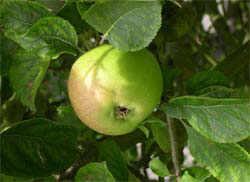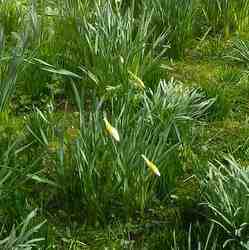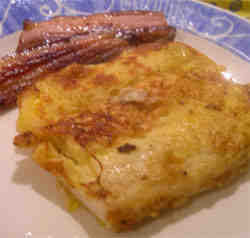Old Fashioned Apple Jelly Recipe
Posted by Fiona Nevile in Jam Jelly and Preserves | 106 comments
A green cooking apple
We always use cooking apples for apple jelly so that it is not too sweet and much more adaptable. For years I only thought of jelly as an accompaniment to meat. The jars opened and enjoyed but usually lost in the depths of the fridge. I cringe now at the thought of the great jellies that must have been wasted on us.
Over the past couple of years we have begun to discover the breadth of the jelly repertoire. Initially, we worked hard trying to make jelly with a good flavour, rather than the ultra sweet stuff that I remember as a child. I asked all my clients for tips. Armed with this unique knowledge, (most of them are good, inventive cooks) and a lot of experimentation we have finally made a small range of jellies that we think are good. This delicate apple jelly is one of the stars.
As we had all these pots of jelly crowding out the larder we were forced to become adventurous. We found that a decent dollop of a stronger jelly in a stew lifted the flavours. We ate it with cheese. We used it in casseroles, as a sauce base for pork and chicken and stirred it into hearty winter soup. We even tried in stir fries (great with a chicken or duck.
We found that dark meat and game cry out for a slightly stronger jelly, such as our damson or wild plum. We also make a punchy sloe and Bramley jelly which adds an extra fillip to a pheasant or venison dish. If we run out of the more raunchy jelly, Danny adds a slug of sloe gin, although I prefer the sharper fruity effect of damson gin. A dash of sloe or damson gin is super in stews, sauces and gravy. You can’t taste the alcohol, just a deep, mellow flavour.
Old Fashioned Apple Jelly Recipe
Ingredients:
- 4 pounds/1.8 kilos of cooking apples (windfalls are fine for this recipe)
- 2 UK pints/1140ml/5 cups of water
- Grated rind and juice of one large lemon
- White granulated sugar (the amount depends on the volume of juice extracted from the simmered, drained fruit. 1 pint/500ml/2 1/2 cups of juice to 1 pound/454gms of sugar. I always make sure that I have a 2 kilo bag of sugar in the larder, just in case I fancy making jelly)
Method:
- Wash the apples, cut out bad bits and chop roughly. There is no need to peel and core the apples.
- Carefully grate the lemon zest from the lemon (we use a zester but a fine grater will do. Try to avoid including the pith as this would make the jelly bitter).
- Place fruit and lemon zest in a large deep heavy bottomed saucepan, or preserving pan. Add the water and bring gently Bring gently to the boil and simmer very gently until all the fruit is soft and mushy (roughly 25 minutes, depending upon how ripe the fruit is).
- Pour the cooked fruit through sterilised muslin. (How do I sterilise muslin? See tips and tricks below). The muslin is often referred to as a “jelly bag”. We use tall buckets to catch the drips from the jelly bags. Rather than hang the bags (conventional method-between two stools) I find it easier to line a large plastic sieve with the muslin. This clips neatly onto the top of a clean bucket. The sieve is covered with a clean tea cloth to protect against flies, as the jelly bag generally drips overnight.
- Measure the apple juice the next day and pour it into a deep heavy bottomed saucepan. Add 454g/1 pound of white granulated sugar for each 570ml/1 pint/2 1/2 cups of juice.
- Add the juice of the lemon.
- Heat the juice and sugar gently, stirring from time to time. Make sure that that all the sugar has dissolved before bringing the liquid slowly to the boil. Continue to boil for about five minutes before testing for a set. (What is testing for a set? See tips and tricks below).
- Toss in a nugget of butter towards the end to reduce the frothing that often occurs.
- When jelly has reached setting point pour into warm sterilised jars using a funnel and ladle. (How do I sterilise jars? See tips and tricks below).
- Cover immediately with plastic lined screw top lids or cellophane tops secured with a rubber band.
Label when cold and store in a cool, dark place. Away from damp. (My jelly is too liquid. See Tricks and tips below)
Tips and tricks:
- What is a jelly bag?
A jelly bag is traditionally a piece of muslin but it can be cheesecloth, an old thin tea cloth or even a pillowcase. The piece needs to be about 18″ square. When your fruit is cooked and ready to be put in the jelly bag, lay your cloth over a large bowl. Pour the fruit into the centre of the cloth and tie the four corners together so that they can be slung on a stick to drip over the bowl. Traditionally a stool is turned upside down, the stick is rested on the wood between the legs and the jelly bag hangs over the bowl. We experimented and now line a sieve with muslin, place it over a bucket and cover the lot with clean tea cloths (against the flies). - How do I sterilise muslin/the jelly bag?
Iron the clean jelly bag with a hot iron. This also works with tea cloths. - What is Jam “set” or “setting point”?
Getting the right set can be tricky. I have tried using a jam thermometer but find it easier to use the following method. Before you start to make the jam, put a couple of plates in the fridge so that the warm jam can be drizzled onto a cold plate (when we make jam we often forget to return the plate to the fridge between tests, using two plates means that you have a spare cold plate). Return the plate to the fridge to cool for approx two minutes. It has set when you run your finger through it and leave a crinkly track mark. If after two minutes the cooled jam is too liquid, continue to boil the jam, testing it every few minutes until you have the right set. The jam is far more delicious if it is slightly runny. - How do I sterilise jam jars?
We collect jars all year round for our jelly, chutney and jam making sessions. I try to soak off labels and store the clean jars and metal plastic coated screw-top lids in an accessible place. The sterilising method that we used is simple. Just before making the jam, I quickly wash and rinse the jars and place them upside down in a cold oven. Set the temperature to 160c (140c fan-assisted). When the oven has reached the right temperature I turn off the heat. The jars will stay warm for quite a while. I only use plastic lined lids for preserves as the all-metal lids can go rusty. I boil these for five minutes in water to sterilise them. If I use Le Parfait jars, I do the same with the rubber rings.
Leave a reply







Yet another brilliant recipe!! I have never ever made fruit jelly, my first was the rosehip and apple jelly this week, it is absolutely delicious!! So, I’m trying the Apple jelly tomorrow! Brilliant place, this site, love it xx
I make my apple jelly with cloves and it seems to enhance the colour and it tastes wonderful as well
I have frozen the fruit after cooking and before straining, when I run our of time to make jelly and don’t want to lose a crop, works just as well
Hi Fiona can you tell me a good applesauce recipe and how to make apple cider. thank you
Also some apple wine
Hi Fiona can you tell me a good applesauce recipe and how to make apple cider. thank you
I was looking for an apple jelly recipe and came across this one. It’s really simple as it has so few ingredients, although having never made jelly before, it took me much longer than I expected.
Anyway, I used my Apple Master to core and slice (but not peel) about 2lb of cooking apples from my back garden. I think they’re Bramley Seedling. The cook down to a pulp.
I’d just made pear jam from my pear tree and I’d saved the cores and peel from that exercise and had about 2lb of them, so I bunged them in with the apples. I left out the grated lemon rind because I couldn’t get our grater to grate them satisfactorily.
The apples quickly cooked down to a mush, but the pear cores bobbed around and stayed stubbornly solid. Eventually, I went chasing them and mashed them with a fork.
When the whole thing was suitably mushy, I used muslin over a strainer, but not having a food-grade bucket, I used a mixing bowl; and once I’d got the easy run-off, I switched to a second mixing bowl and left it to drip for about 20 hours. One mixing bowl got hidden in the oven and the other in the microwave during that time. That way the cats couldn’t get to them!
My yield was 2 pints, so I added in my 2lbs of sugar and it dissolved nicely. Annoyingly, the pear crumble I had in the oven was ready to eat just as the jelly-making was starting to hot up, so the pear crumble consumption had to wait.
I thought I was never going to reach setting point, but in the end I did. A scum formed and next time I’ll know to skim it straight away. I dodged it and got three lovely clear half pound jars. Then I tried putting the remainder back on the hob hoping that the scum would rise again, but it didn’t, so I got two slightly cloudy half pound jars.
The flavour is lovely and delicate. There may be a hint of the woodiness of the pear cores and stalks about it, but as I didn’t add any cloves or cinnamon, that’s no bad thing.
This may turn out to be a jelly to spread on toast rather than one to eat with my turkey, but I’ll give it a go and see what it’s like.
It’s such a sense of achievement to have done things with my apple and pear crops this year. I’ve lived with them in my back garden for 15 years and have just let the birds take them in past years. The pear turns out to be super-delicious, although I wonder whether the jam I made (using a RHS recipe) might turn out to be just too sweet. I think it might be one to apply sparingly to bread or toast – but as I only made three half-pound jars, eking it out is no bad thing.
Thankyou for reading:-)
I always test the extracted juice for pectin as one can then judge how much sugar to add according to the level of pectin. Certo is a brand of pectin available in stores in N. America. This is part of what I wrote for some beginner jelly makers (and it refers to American cups):-
……At this point it is useful to test for pectin as fruits low in pectin such as cherries or strawberries may need to have extra pectin added.
Test for Pectin
Put 1 tablespoon of alcohol (methyl hydrate/methanol) in a glass.
Add 1 teaspoon of juice.
Allow to stand for a minute or two and then gently stir
when a clot will be formed.
If the clot is large and solid, the fruit is rich in pectin
If the clot is moderate sized and not very firm, the fruit
is moderately rich in pectin.
If the clot is broken up into many small pieces, the fruit is
poor in pectin.
Sugar is very important in jelly (and jam) making. If too much or too little is added the jelly will not set. One has to have the right balance (approximately) between sugar and pectin.
If the extracted juice is high pectin, use 2 cups of juice + 2¼ cups sugar
If the juice is moderate in pectin, use 2 cups juice + 1¾ cups sugar
If the juice is low in pectin, add Certo and follow their instructions.
(Note – there are two types of Certo, liquid and powder. Always add the powder Certo BEFORE the sugar and add the liquid Certo AFTER the sugar).
Sterilize the jars in the oven at 250°F. Sterilize the lids in boiling water.
etc etc
my jam is like honey,plz help
kindly tell me that how much juice should extract from 1.8 kilograms of apples.
Perfect simple recipe to deal with all the windfalls and blemished Worcester pear main apples I have this year. These make a delicious scented jelly requiring no flavours. Can you tell I’m a purist. I know the goats will not like this recipe as they love a bed time treat of sliced apples.